Old Russian architecture and painting. Masterpieces of ancient Russian painting
The interest in ancient Russian painting in our country is now enormous, and the difficulties of its perception among those who turn to it today are no less enormous. Almost everyone experiences them, both teenagers and adults, and even people who are otherwise well educated, although in Ancient Russia her painting was available to everyone. The fact is that these difficulties are rooted not just in the lack of knowledge of an individual, their reason is much wider: it is in the dramatic fate of ancient Russian art itself, in the dramas of our history.
Christianity in Russia is a little over a thousand years old, and the art of icon painting has the same ancient roots. The icon (from the Greek word for “image”, “image”) arose before the birth of ancient Russian culture, received wide use in all Orthodox countries. Icons in Russia appeared as a result of the missionary activity of the Byzantine Church at a time when the significance of church art was experienced with particular force. What is especially important and what was a strong inner impulse for Russian ecclesiastical art is the fact that Russia adopted Christianity precisely at the epoch of the revival of spiritual life in Byzantium itself, the epoch of its dawn. During this period, nowhere in Europe was church art as developed as in Byzantium. And at that time, the newly converted Russia received, among other icons, as an example of Orthodox art, an unsurpassed masterpiece - the icon of the Mother of God, which later received the name of Vladimir.
Through the fine arts, ancient harmony and a sense of proportion become the property of Russian church art, enter into its living fabric. It should also be noted that for the rapid development of the Byzantine heritage in Russia there were favorable prerequisites and, one might say, the ground had already been prepared. Latest Research allow us to assert that pagan Russia had a highly developed artistic culture. All this contributed to the fact that the cooperation of Russian masters with Byzantine ones was extremely fruitful. The newly converted people turned out to be able to accept the Byzantine heritage, which nowhere found such favorable soil and nowhere gave such a result as in Russia.
Since ancient times, the word "Icon" has been used for individual images, usually written on a board. The reason for this phenomenon is obvious. The tree served as our main building material. The vast majority of Russian churches were made of wood, so not only mosaics, but also frescoes (paintings on fresh, damp plaster) were not destined to become the common decoration of the temple interior in Ancient Russia.
With their decorative effect, ease of placement in the church, brightness and strength of their colors, icons painted on boards (pine and lime, covered with alabaster ground - gesso) were the best suited for the decoration of Russian wooden churches.
No wonder it was noted that in ancient Russia the icon was the same classical form. visual arts, as in Egypt - a relief, in Hellas - a sculpture, and in Byzantium - a mosaic.
Old Russian painting- the painting of Christian Russia - played a very important and completely different role in the life of society than modern painting, and its character was determined by this role. Russia was baptized by Byzantium and together with it inherited the idea that the task of painting is to "embodie the word" to embody the Christian dogma in images. Therefore, the basis of ancient Russian painting is the great Christian “word”. First of all, this Holy Bible, Bible (“Bible” in Greek - books) - books created, according to Christian doctrine, by the inspiration of the Holy Spirit.
It was necessary to embody the word, this grandiose literature, as clearly as possible - after all, this incarnation was supposed to bring a person closer to the truth of this word, to the depth of the dogma that he professed. The art of the Byzantine, Orthodox world - all countries within the sphere of cultural and religious influence of Byzantium - solved this problem by developing a deeply unique set of techniques, creating an artistic system that was never seen before and never repeated, which made it possible to embody the Christian word in an unusually full and clear way. picturesque image.
For many centuries, ancient Russian painting carried people, unusually brightly and fully embodying them in images, the spiritual truths of Christianity. It was in the deep disclosure of these truths that the painting of the Byzantine world, including the painting of Ancient Russia, the frescoes, mosaics, miniatures, icons, acquired extraordinary, unprecedented, unique beauty.
Over time, the art of the entire Byzantine world, and the art of Ancient Russia, fell into oblivion. The Byzantine Empire fell under the blows of the conquering Turks, the once Christian countries of Asia Minor and many Slavic states were conquered by Muslims. In these troubles, having survived the Tatar-Mongol invasion, Russia alone survived in essence. After the fall of Byzantium, it was the true center of Orthodox culture.
Oblivion, ruin befell the ancient Russian culture, including icon painting, not as a result of conquest by foreigners, but at the time of the highest rise of Russian statehood under Peter I. Peter's reforms, which turned Russia to the West, rejected cultural heritage Ancient Russia. Russian painting after the Petrine reforms, including church painting, is built on these new Western European principles. And although purely religious respect was preserved in the Europeanized, enlightened Russian society, the very differences between ancient Russian and European painting were perceived by him only as evidence of Russian backwardness and barbarism. Gradually, all this painting, like all pre-Petrine antiquity, fell into oblivion. The ancient artistic system in a greatly simplified form was preserved only in peasant icon painting, the centers of which were several “icon-painting” villages - Palekh, Mstera and Kholuy.
But, fortunately, this oblivion of the ancient national roots was not final in Russia. A hundred years after the reforms of Peter the Great, a new one, created precisely as a result of the reforms, turned to him. Russian culture, Russian intelligentsia.
Interest in ancient Russian culture caused an appeal to its painting. Already in the "History of the Russian State" Karamzin mentions ancient Russian artists, provides information about their works. They become the subject of study for historians, but the true discovery of icon-painting treasures occurred later. The fact is that the people of the 19th century simply did not really see the ancient Russian icon painting. Darkened, covered with dust and soot, frescoes and mosaics that survived in ancient temples, and icons literally became invisible - the main, most numerous part of the ancient Russian heritage. After all, not every church was decorated with frescoes and especially mosaics in antiquity, and icons were necessarily not only in every temple, but also in every house. The reason for this invisibility of the icons is in the special pictorial technique in which they were created. The board on which the icon was to be written was covered with gesso or primed fabric - canvas, and the image itself was applied with tempera primer, i.e. mineral paints. And on top of the image was covered with a layer of drying oil. Drying oil shows color well and, more importantly, perfectly protects the icon from damage. But drying oil has the ability to darken over time, and over 70-100 years it darkened so much that it almost completely hid the painting underneath. In ancient times, in Russia, they knew and used methods for removing darkened drying oil, i.e. ways of "clearing" ancient painting. But these methods were laborious, and over time, the icons began not to be cleared, but “renewed”, i.e. a new image was written over the darkened drying oil. Often, several such renovations were made on ancient icons over the centuries - in this case, the original painting was covered with several layers of inscriptions, each of which was covered with drying oil. Thus in early XIX century, by the time when interest arose in pre-Petrine culture, the icons of the 17th century were already darkening. On all the ancient icon boards, only silhouettes appeared, the contours of the images appearing through the darkened, smoked drying oil.
Among educated people there were a few people who were especially sensitive to art, who managed to feel the artistic power lurking in this blackened painting. Thus, in 1840, the historian Ivanchin-Pisarev, who sowed the Trinity-Sergius Lavra, was able to see the most valuable monument of art in the greatly darkened "Trinity" by Andrei Rublev stored there.
Until the middle of the 19th century, the general idea remained that "arts were established in our fatherland by Peter I." It was not until the second half of the century that such an idea was destroyed. Russian historical science played an important role in this. Particularly significant were the successes she made in the study of ancient literature and ancient literature. It was largely due to this that scientists of that time paid attention to ancient icon painting, which was closely connected with the word, with literature, and were able to assess the exact and deep correspondence of the icons to the literary source. The recognition of artistic significance for ancient painting, the growth of interest in it caused the appeal of wide circles of educated people to the folk environment where this painting, like all pre-Petrine antiquity, still continued to live. For iconography, first of all, such an environment was the environment of the Old Believers, the environment of schismatics, i.e. peasants and merchants, whose ancestors in the middle of the 17th century deviated from the Orthodox Church, not accepting some of the innovations undertaken at that time. The Old Believers cherished the ancient icon as free from these innovations, not spoiled by them, highly revered it and retained a peculiar understanding of its beauty. Communication with the Old Believers gave therefore the opportunity to get acquainted with a large number belonging to them, the icons they collected, which in itself was important, as it expanded the understanding of ancient icon painting. But what is even more important - the Old Believers learned to appreciate that “subtlety of ancient writing”, which they themselves appreciated in the icons they collected. They learned from them to see through the darkened drying oil the virtuosic accuracy of the drawing, the harmonious clarity of the composition.
At the end of the 19th century, numerous collections were formed in Russia. The most famous of them are the collections of A.V. Morozov a, I.S. Ostroukhov, in which the icons were no longer collected as ancient monuments, but as works of art. At the end of his life, the famous Tretyakov also began to collect icons, and, realizing the artistic significance of the collection of icons he had collected, he bequeathed it with his painting to the (Tretyakov) gallery.
Naturally, both the owners of icon collections and people close to them had a desire to see what was under the blackened drying oil, to see the ancient painting they had collected in its present form. At the beginning of the 20th century, cleaning of the icons was undertaken. The initiator of these clearings was I.S. Ostroukhov, who by that time was not only the owner of his own icon collection, but also a trustee of the Tretyakov Gallery. Thanks to his knowledge and experience, the performers of this work were also found. Masters-icon painters, natives of ancient icon-painting villages, were involved in it. Knowing well the technology of the icon, remembering the old-fashioned methods, they coped with the task, removed the darkened drying oil from the surface of the icons and later records - they opened the original ancient painting. From that moment began the real discovery of ancient Russian icon painting. As a result of the clearing, or restoration, as we now say, the icons appeared so new and unexpected that even experts were surprised. The myth of the "black icons" has shattered to dust.
Following the first clearings, many others followed: in private collections, museums, and temples, where, in addition, ancient frescoes began to be cleared and uncovered.
The discovery of ancient Russian painting at the beginning of the 20th century, the recognition of its artistic significance, revived the understanding of its true spiritual meaning. But the further destinies of both ancient Russian art itself and its comprehension were affected by the great and formidable historical events of the early 20th century that took place in the country, the transformations as a result of the October events of 1917. The recognition of atheism as a state worldview led to the persecution of the Christian word, to its almost complete withdrawal from popular use, and for a long time made it impossible to study the spiritual meaning of ancient icon painting. It threatened the destruction of the very works of ancient Russian art. Thousands of temples were closed, many of them, including ancient icons, were destroyed.
However, the recognition of icon painting as art, integral part culture played a positive role: museums opened their doors for icons, where ancient icons collected by collectors and icons from closed temples were received. Since the post-war years, when interest in national culture began to revive, the icon as a phenomenon of this culture began to return to museum exhibitions: at first very timidly, but in the 60-80s already quite widely and openly. The processes taking place now in our society have already led to the return of the ancient icon to churches.
The same cannot be said about the "schedule" of the churches; here, as before, Greek foreigners worked together with their Russian students. In 1343 Greek craftsmen "signed" the cathedral church of the Assumption of the Virgin in Moscow. Theophanes the Greek painted the church of St. Archangel Michael in 1399, and in 1405 the Church of the Annunciation in the princely court, together with Russian masters Prokhor, an elder from Gorodets, and a monk Andrei Rublev. In Novgorod, the Greeks also figured as church painters - Isaiah Grechin (in 1338), the already mentioned Feofan and others. But their own masters were enough. So, in 1334 the monastery church of St. The Savior in Moscow was painted by the students of the Greeks - Gaitan Semyon and Ivan with their students and the "team". The painter was Metropolitan Peter, who, according to legend, painted two icons that are now stored in the Assumption Cathedral, St. Stephen of Perm, teacher Dionysius Glushitsky and others. But the most famous painter among the Russian people was Andrey Rublev, who participated, as they say, in the schedule of the Annunciation Cathedral in Moscow. Together with the icon painter Daniel, he painted the cathedral church of the Virgin in Vladimir; He is also credited with the image of St. Trinity in the Sergius Lavra. Andrei Rublev was a man passionately devoted to his work, who found in him the greatest pleasure, considering him charitable and soul-saving. He became extremely famous among his contemporaries and created a whole school of imitators. Of the monuments of church fresco painting of the specific era, the frescoes of the Novgorod Transfiguration Church on the Trade side deserve special attention - the work of the aforementioned Theophanes the Greek, the image of two holy Russian princes in the choirs in the church of St. Theodore Stratelates in Novgorod (XIV century), three faces of saints in the clothes of Russian soldiers with a spear, shield, armor and helmet, located in the Church of the Transfiguration of the Savior in Kovalev near Novgorod, frescoes of the Assumption Cathedral in Vladimir, painted by Andrei Rublev, and frescoes of the Assumption Cathedral in Zvenigorod. In the works of icon painters of the specific era, as in the works of the previous era, conventionality, monotony of methods and expression, little personal, individual creativity reigns. The general character of icon painting is the same as in the previous era.
Foundry, chased, jewelry and other artistic crafts.
In north-eastern Russia, other artistic crafts were supported mainly by church needs, and above all foundry. Copper bells were cast for churches, tin or lead “boards” for roofs, copper boards for doors, candlesticks and chandeliers, tin, copper and silver vessels, etc. Most of these products were prepared by Russian craftsmen. So, in 1420, the Pskovites ordered from Moscow a special craftsman to make lead boards with which it was supposed to upholster the church of St. Trinity. In Moscow, already in 1410, a duty was levied on silver castings. But larger and more skillful things were still made by foreigners. In 1345, three large bells and two small ones were cast in Moscow by master Boris the Roman; even earlier, in 1342, he was called from Moscow to Novgorod and cast a large bell there for St. Sofia. Gilders continued to exist and work in Russia, gilding domes or domes of churches, shrines or coffins of saints, sometimes even church doors. But in general, given the poverty of the rulers and the population, this craft, of course, could not flourish at a specific time, just as the chased and jewelry business could not flourish. Precious decorations of church utensils and vestments, icons, attire of princes and boyars, became a rarity, were carefully stored and passed down as a rarity. Spiritual letters of Moscow and other princes list in detail hats, fur coats, necklaces, chains, crosses, icons, boxes, etc. as a great value. Of the precious things of the specific era, the sakkos of Metropolitan Photius, kept in the Moscow Patriarchal Sacristy, is artistically remarkable. It is embroidered in gold, silver and silk with images of holidays and saints and portraits of Grand Duke Vasily Dmitrievich, his wife Sophia Vitovtovna, the Greek Emperor John Paleologus, his wife Anna (Basily's daughter) and, finally, the Metropolitan himself. The portraits of the Grand Duke and his wife have Slavic signatures, while those of the Byzantine Emperor, his wife and the Metropolitan have Greek signatures. It can be seen that the Greeks did this sakkos after all. Vasily Dmitrievich is depicted in a red caftan with checks, belted low, in narrow green ports, hidden in high boots made of red morocco, intercepted in three places with clasps; a green cloak with gold streaks on a blue lining is thrown over the top. On the head of the Grand Duke there is a transparent golden crown, with crosses and with a red velvet crown; in his right hand he holds a scepter studded with pearls. Grand Duchess Sophia is dressed in a sundress made of silver brocade with red checks in gold frames; the sundress is decorated with a gold necklace and the same belt; over the sundress, a fur coat, or a long cloak, is worn, gold with silver circles and blue and red crosses in them. The crown on the princess is almost the same shape as on her wife. One must think that these images are still an approximate reproduction of reality and, therefore, can give some idea of the decoration of the then richest princes in Russia - Moscow. Other princes could hardly dress like that; still less could they allow significant luxury in the decoration and attire of the boyars and the servants of the princes. The external way of life of the ruling and wealthy circles of Russian society, by all indications, was poorer, grayer at specific times than in the Kievan era.
500 Treasures of Russian Painting Evstratova Elena Nikolaevna
Old Russian painting
Old Russian painting
“Old Russian icon painting expresses the deepest that is in Old Russian culture; moreover, we have in it one of the greatest world treasures of art,” wrote the Russian religious philosopher E. Trubetskoy. Appeal to the iconography of Ancient Russia is quite difficult for a modern viewer. In the icon, we are dealing with an aesthetic system, the meaning of which cannot be understood without ideas about medieval Christian culture and spiritual life.
By the time Russia adopted Christianity in the 10th century, Byzantium already had a coherent, well-thought-out artistic system. According to the chronicler, it was the delight of the ambassadors of Prince Vladimir of Kyiv from the majestic joy of Orthodox worship in the main Byzantine church of St. Sophia of Constantinople that played a decisive role in his choice of the Orthodox faith. Undoubtedly, the image of the temple itself made a strong impression on the ambassadors: a huge dome soaring high, streams of golden light, sparkling mosaics on the walls. This is how they described their impressions: “And we didn’t know whether we were on earth or in heaven: for there is no such sight and beauty on earth, and we don’t know how to tell about it. We only know that God dwells there with people and their service is better than in all countries.
The first icons - sacred images on boards - appeared in Byzantium in the 6th century. Over the centuries, the Church has developed and approved uniform rules for the image, allowing you to convey the invisible, mountainous world, testifying to the majesty and power of God. These rules are called "icon-painting canon". In the icon-painting canon, the “ancient” foundations of the icon are preserved: the human body and the earthly world remain recognizable, there are often traces of portraiture in the guise of saints, the folds of their clothes with their plastic splendor sometimes resemble the best antique sculptures. At the same time, certain patterns were used to depict each saint or plot of Holy Scripture - compositional schemes that icon painters could not violate.
According to Trubetskoy, the main thing in the icon is “the joy of the victory of the God-man over the beast-man.” In order to perceive this joy and draw closer to God, a person must accomplish a spiritual feat, struggling with the temptations of life. Therefore, the carnal principle is muted in the icon: the elongated figures of the saints are almost transparent, incorporeal, motionless; without touching the earth, they seem to soar, rushing towards the heavenly world, staying in eternity, since the heavenly world is eternal and unchanging in its essence. State inner world characters in iconic images are often conveyed by intense, questioning, stern or all-encompassing eyes filled with love on the haggard, ascetic faces of saints. The icon acts as a carrier of the spiritual and eternal, through the icon a person receives communication with the divine world.
On one icon, events are often combined that, according to the Holy Scriptures, took place in different time and in different places, since the plots of icon painting are not connected with the earthly dimension of time, their heroes are in unearthly time and space.
In Western European painting, starting from the Renaissance, artists conveyed colors in paintings that were accessible to earthly vision. Icon paint colors do not always correspond to the colors of the “visible world”. They are perceived as reflections of the divine light that emanates from Christ forever, but is not visible in his earthly incarnation, so each of the colors has its own symbolic meaning. So, for example, the golden color denotes the light of divine radiance, it was often used for the background of icons. Golden thread-rays (assist) cover the wings of angels, the robe of the Mother of God and the Divine Child. Painted with blue and greenish tones celestial spheres where angels live. White color is often present in the clothes of the angels of saints as a symbol of purity, detachment from the world. The purple color in Byzantium was a sign of imperial dignity, so in the icon it means the greatest power. The Mother of God is always depicted in a purple cloak. Black color is very rare in icons - a symbol of hell and death.
The icon is created for the temple, constituting a single whole with its internal space. That is why the composition of the icon is built according to the rules of architectural composition. The semantic center in it coincides with the visual, compositional center, the arrangement of figures often obeys the laws of symmetry.
Most icons are anonymous. The medieval artist felt himself not the creator of his own ideas, but the embodiment of the Highest Truth, the bearer of which was the earthly Church. The names of prominent icon painters were included in chronicle evidence - this is how we learned about Andrei Rublev, Daniil Cherny, Dionysius. Icons began to be signed only in the 17th century, when, due to the influence of Western European art, many of the former aesthetic principles were lost in it, and the artist began to realize himself as a creator.
Russian icons have become a part of the treasury of world art quite recently, about 100 years ago. The traditional technology of painting icons required covering them with drying oil, which darkened with time. In addition, ancient icons were often updated - a new image was applied on top of the previous paint layer. As a result, the original painting was hidden from view, and the darkened, sooty icon was removed from the temple to special storage facilities at temples and monasteries. The iconostasis was replaced with “magnificent” icons of the new painting to replace the old icons. On the eve of the First World War, restorers learned how to clear old, often sooty boards, and the amazed public saw the extraordinary beauty of the bright colors and exquisite lines of ancient Russian icon painting. Since that time, a boom in the collection of icons began in Russia. They were searched for in remote Old Believer sketes, among abandoned things on bell towers, in sheds among rubbish ... After restoration, they became part of personal collections, ended up in museums. All this coincided with the rise of Russian religious philosophy in the early twentieth century. The works of E. Trubetskoy, P. Florensky and other philosophers revealed the essential relationship between the aesthetic perfection of icon painting and its spiritual, theological meaning.
After the adoption of Christianity, Russian masters studied with visiting Byzantine artists, adopting the same aesthetic principles for the entire Orthodox world. Numerous images of icon painting were sent to Russia. Among the most famous images that arrived from Constantinople is the icon of Our Lady of Vladimir by an outstanding Byzantine master of the 12th century, which became both a standard for Russian icon painters and a precious miraculous shrine associated with the formation of the Russian state.
In the first centuries of the existence of icon painting in Russia, the national school was not yet clearly expressed. The images on the icons of the 13th century retain Byzantine stern expression, monumental grandeur, classical clarity and balance. The destruction of Constantinople by the crusaders (1204) and the Mongol-Tatar invasion of Russia (1237) broke the cultural unity of the Orthodox world. Russia found itself in forced isolation, many icon-painting centers fell into ruin. Novgorod and Pskov escaped conquest. It is from Novgorod that most of the unique large icons of the pre-Mongolian period (“Ustyug Annunciation”, “Savior Not Made by Hands”, etc.) originate.
At the turn of the XIV-XV centuries, a spiritual turning point began in Russia, associated with the Battle of Kulikovo, with the weakening of the yoke. Metropolitan Alexy and Sergius of Radonezh prepared the political and moral revival of the Russian land. Gradually, Moscow rises as the spiritual and political center of the state, outstanding icon painters begin to work here - the Byzantine master Theophanes the Greek, who arrived from Novgorod, and the brilliant icon painter, ranked by the Church as a “reverend”, Andrei Rublev.
Rublev's work combined all the best achievements of the Byzantine art system from Russian warmth softness of intonation. The highest achievement of the master was the icon "Trinity". The image of the "one and indivisible" Holy Trinity inspired and instructed medieval people on the idea of peace and unity, healed human souls in the days of internecine hostility and destructive wars.
At the end of the 15th century, the work of another illustrious master, Dionysius, fascinated and influenced his contemporaries. In the elongated proportions of fragile, incorporeal, as if floating figures, in the enlightened coloring, built on exquisite color combinations, there is a sense of the festivity of the beautiful mountain world (“Metropolitan Alexy with Life”, “Rejoices in You”, etc.).
Simultaneously with the Moscow school, icon-painting centers continued to exist in other Russian cities: Veliky Novgorod and Pskov, Tver and Suzdal. The Novgorod school of icon painting reached its peak in the 15th and early 16th centuries. Externally frozen, but internally tense images of Novgorod icons seem to be filled with inhuman energy and strength, ready for contact with the supersensible world (“Ilya the Prophet”). In the conditions of the Novgorod “freemen”, unique iconographic plots were born related to real events (“The Miracle from the Icon of the Mother of God of the Sign”).
Representatives of icon-painting centers influenced each other, and by the middle of the 16th century a single all-Russian style was being formed. By the end of the 16th century, icons were increasingly filled with complex church-historical allegories (“The Militant Church”), rare, difficult to interpret iconographic motifs (“The Last Judgment”), losing their former clarity and conciseness of the artistic language.
In the 16th century, icons became a luxury item. The ornament, the exquisite beauty of clothing, the magnificence of the landscape begin to interest the icon painter more than the spiritual content of the image. This was most clearly manifested in the icons of the "Stroganov school". This concept is traditionally called the work of artists who worked at the end of the 16th and in the first decades of the 17th century for the “eminent people” of the Stroganovs (Prokopiy Chirin, Istoma Savin and his sons Nazariy, Nikifor, Fedor and Bazhen, etc.).
FROM mid-seventeenth century artistic language Russian icon painting departs from the traditional canon and medieval aesthetic norms: elements of direct perspective appear in the composition, and elements of volume appear in the lettering of faces. The irreconcilable schismatic Archpriest Avvakum defended the old icon-painting traditions in his message: “They paint the image of Emmanuel of the Savior - his face is puffy, his lips are red, his hair is curly, his arms and muscles are thick ...”. These new techniques were expressed in the work of the "royal painter" Simon Ushakov and his followers ("The Savior Not Made by Hands", etc.).
In the 18th century, the icon-painting tradition mainly continued to exist in "living-like" images. The emerging secular art is gradually pushing the traditional icon to the periphery. The traditions of the former icon-painting canon continued to live in the Old Believer environment, in separate "folk" icon-painting centers - Palekh and Mstera.
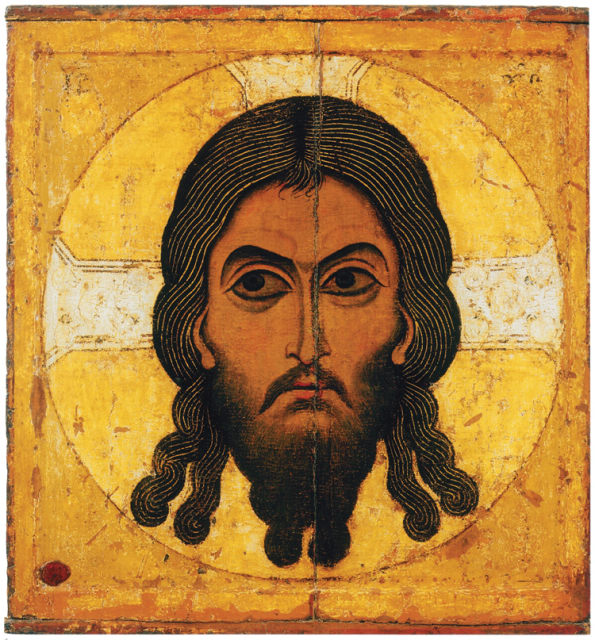
Savior Not Made by Hands.Second half of the 12th century Novgorod. State Tretyakov Gallery, Moscow
According to legend, the king of the Asia Minor city of Edessa, Avgar, who suffered from an incurable disease, sent an artist to Christ to depict the face of the Savior, which would help him heal. However, the miraculous radiance around Christ prevented the artist from capturing his appearance, and then Christ washed his face, wiped it with a cloth (brust), on which his face was miraculously imprinted - the Image Not Made by Hands. King Avgar was healed from the Image of the Savior Not Made by Hands, after which the Image was placed on the city wall, protecting Edessa from enemies, and in 944 it was transferred to Constantinople and became the basis for the iconographic type - the Savior Not Made by Hands.
On the icon, the face of the Savior is strict and severe, almost perfectly symmetrical. Restrained coloring is built on subtle combinations of ocher tones. Initially, the icon looked more elegant: the bright ornament of the branches of the cross on the halo was lost.
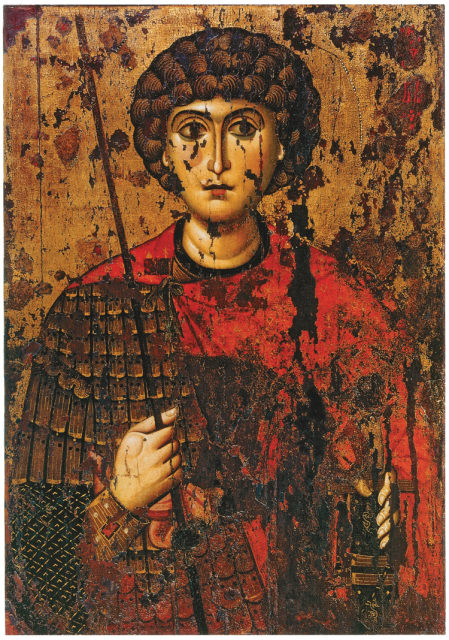
St. George.OK. 1170. Assumption Cathedral, Kremlin, Moscow
St. George, a soldier of the Roman emperor Diocletian, was severely tortured and beheaded for openly professing the Christian faith. Bold and resolute, he became famous for many miracles, which are often depicted on icons. In Russia, George was revered as the patron and protector of herds from predatory animals.
One of the most ancient icons depicting the saint comes from the Yuriev Monastery near Veliky Novgorod. Executed, probably by a Byzantine master, it bears the imprints of the capital's Constantinopolitan style. The huge eyes of the still very young, beardless Georgy look thoughtfully and sternly, in his hands he tightly squeezes the spear and the hilt of the sword, thereby appearing in the guise of "transcendental" heavenly glory and at the same time as the personification of military prowess.
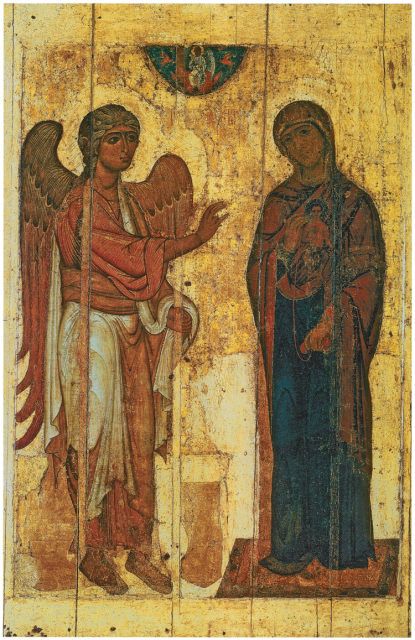
Annunciation Ustyug.12th century Novgorod. State Tretyakov Gallery, Moscow
The plot is based on the event described in the Gospel of Luke - the archangel appeared to the Virgin Mary with the good news that she would give birth to a child who would be called the Son of God. Mary bowed her head in obedience to God's will. The icon contains a rare iconographic detail: the incarnated Christ Child is represented in the bosom of the Mother of God. The upper segment depicts Christ the Old of Days (Ancient of Days) - a special iconographic type, which is considered an Old Testament prototype of Christ. From his hand came a beam (not preserved), penetrating into the bosom of the Virgin.
According to legend, at the moment of the annunciation, Mary was spinning a veil for the Jerusalem temple from purple yarn, which was symbolically identified with the flesh of Christ, that is, the yarn in the hands of the Mother of God recalls that the Savior received his human nature from her immaculate flesh.

Nicholas with selected saints.The end of the XII - the beginning of the XIII century. Novgorod. State Tretyakov Gallery, Moscow
The veneration of St. Nicholas, the archbishop of the Asia Minor city of Myra Lycian, celebrated and loved by the people, began already in the second half of the 4th century, shortly after his death. In Russia, he was revered as a miracle worker and patron of sailors.
This image demonstrates the oldest iconographic type of St. Nicholas. On a silver background there is a half-length image of a saint with a blessing gesture and a Gospel on his left hand. Iconic image of St. Nicholas, of course, has a portrait resemblance to the famous bishop. His tense, stern and at the same time noble face is filled with spiritual concentration. In the central part of the upper field there is a depiction of the Altar prepared and Saints Cosmas and Damian. On the side margins there are three rows of revered Novgorod saints in pairs, among them Boris and Gleb with swords and martyr crosses and Flor and Laurus; below - the holy women-martyrs.
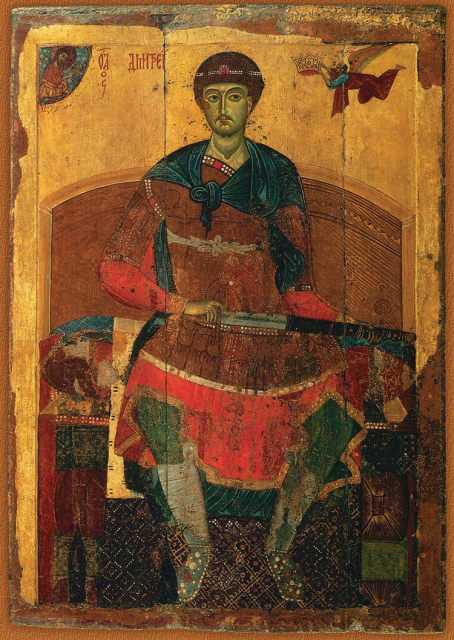
Demetrius of Thessalonica on the throne.End of the 12th century Vladimir-Suzdal school. State Tretyakov Gallery, Moscow
St. Demetrius of Thessalonica was especially revered during the reign of Grand Duke Vsevolod the Big Nest (baptized Dmitry) - the founder of Dmitrov. According to legend, Dmitry of Thessalonica was the governor of the city of Thessalonica (Thessalonica) and suffered during the persecution of Christians under the emperor Diocletian. He was revered as a patron Slavic peoples(it is assumed that he was a Slav by origin) and princely power.
In a rare "throne" image, Dmitry of Thessalonica appears as the heavenly patron of the earthly ruler - Grand Duke Vsevolod; this is evidenced by the princely crown on his head and a half-naked sword (the saint seems to be preparing to present it to Vsevolod as a symbol of his princely dignity). Before us is a solemn and majestic image of an ideal ruler and warrior-defender.

Our Lady of the Great Panagia (Oranta).First third of the 13th century Yaroslavl. State Tretyakov Gallery, Moscow
This image combines two iconographic types of the Mother of God. "Oranta" (from the Latin "orant" - "prayer") - the image of the Mother of God with prayerfully raised hands. “Panagia” (translated from Greek as “All-holy”) - the Mother of God with a medallion on her chest with the image of the Infant Savior Emmanuel, symbolizing the sacrifice - the body of Christ. The monumental figure of the Mother of God with outstretched hands resembles a chalice - a liturgical vessel, at the bottom of which is a prosphora (a symbol of the body of Christ). The light, radiant coloring in the writing of faces, the abundance of gold leaf in the background and draperies of clothes represent the Mother of God with the Child as a manifestation in the world of Divine light.
The icon was discovered by restorers in 1919 in one of the storerooms of the Spaso-Preobrazhensky Monastery in Yaroslavl, which is why it is often called the Yaroslavl Oranta. It is believed that it was executed for the Transfiguration Cathedral, founded in 1216.
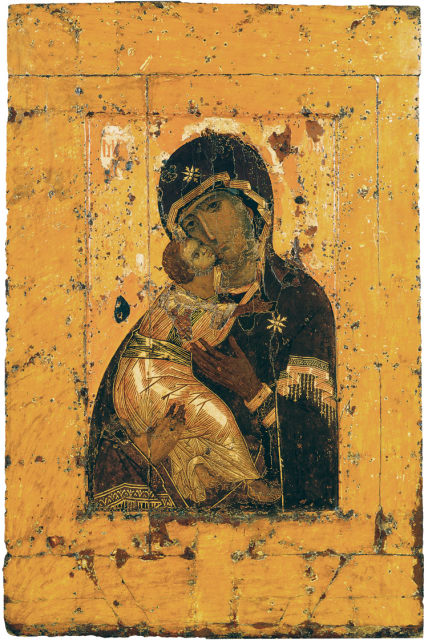
Our Lady of Vladimir.First third of the 12th century Constantinople. State Tretyakov Gallery, Moscow
The icon of Our Lady of Vladimir was brought to Kyiv from Byzantium. In 1155, Prince Andrei Bogolyubsky moved the icon to the Assumption Cathedral in Vladimir, where it became famous for numerous miracles and survived the Mongol-Tatar devastation. During the invasion of Tamerlane on August 26, 1395, the icon was solemnly transferred to Moscow, and on the same day, Tamerlane, due to the fear and trembling that seized him, refused to fight and left Russia. Our Lady of Vladimir is one of the most perfect examples of the iconographic type "Tenderness". Mary carefully supports the Infant Jesus with her right hand, and he clings to his mother, embracing her by the neck and pressing against her cheek. Their embrace is a prototype of the fullness of Divine love, the highest embodiment of which is the sacrifice made by Christ for the salvation of people. The huge penetrating eyes of the Mother of God are full of “otherworldly” love and eternal, “transcendental” sorrow, they are directed towards people who are waiting for help, protection, salvation.
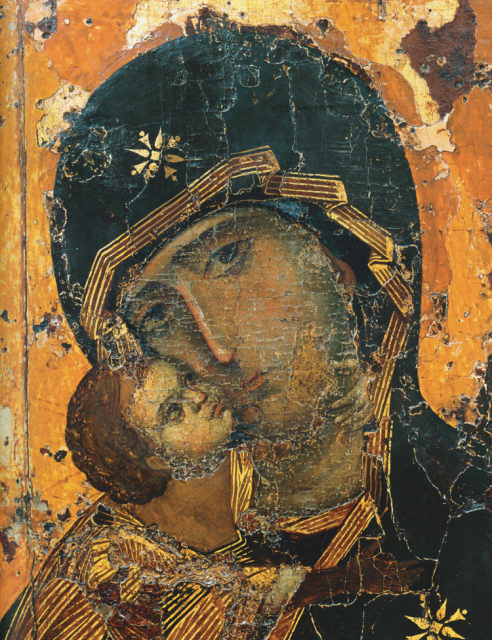
Our Lady of Vladimir.Fragment
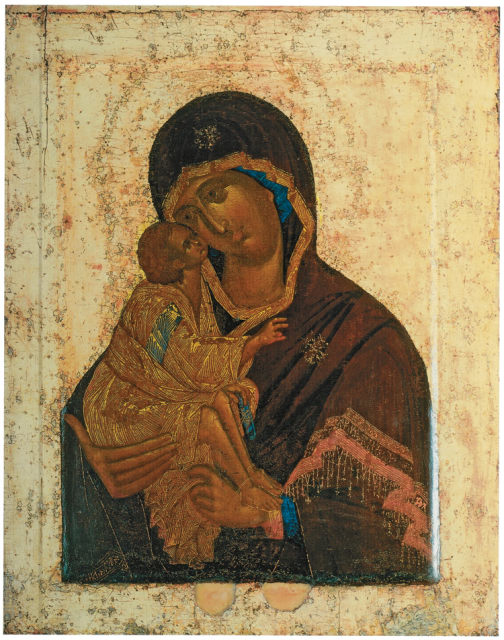
Theophanes the Greek (?). Our Lady of the Don.1380–1390? State Tretyakov Gallery, Moscow
Researchers believe that this icon was made by Theophanes the Greek, an outstanding Byzantine master who worked a lot in Russia. In the guise of the Mother of God and the Infant clinging to her, the traditional Byzantine severity is softened. The energy of light reflections on the face of the Mother of God transforms the painting, creating an image of perfect spiritual beauty, filled with the radiance of Divine glory. The image of the transformed mountain world was enhanced by the lost golden background and sparkling golden halos. According to church tradition, Dmitry Donskoy prayed before this icon on the eve of the Battle of Kulikovo, hence its name. Today, many researchers believe that the icon was painted for the Assumption Cathedral in Kolomna later, around 1392. According to historical sources, Ivan the Terrible turned to the icon when he went on a campaign to Kazan. With the intercession of the icon (after the prayer of Tsar Fyodor Ivanovich) they associated the salvation of Moscow from the raid of the Crimean Tatars by Khan Kazy Giray in 1591.
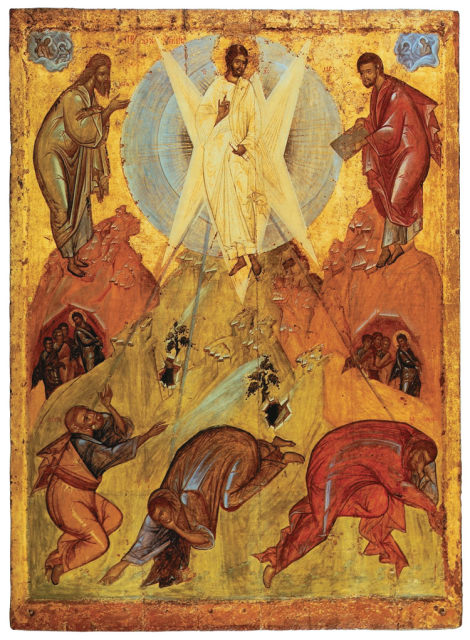
OK. 1403. Moscow. State Tretyakov Gallery, Moscow
According to the Gospel, Christ with three disciples (Peter, James and John) ascended Mount Tabor and "transformed" before them - revealed his Divine nature: "and His face shone like the sun, and His clothes became white as light" (Matt. ., 17:1-9). The prophets Elijah and Moses appeared to him, and a voice was heard from heaven: “This is my beloved Son, in whom I am well pleased; Listen to him" (Matthew 17:1-9). The disciples, seeing this, were greatly frightened and fell on their faces. Jesus touched them and told them to stand up and not be afraid.
The icon skillfully combines scenes that took place at different times. On the left, Christ with the disciples ascends the mountain. In the upper part of the icon, Christ is depicted in a halo of luminous mystical Tabor Light at the moment of miraculous transfiguration and the prophets. Below, the prostrate apostles are closed from the dazzling Divine light, on the right, Christ, having calmed the disciples, descends with them from the mountain.
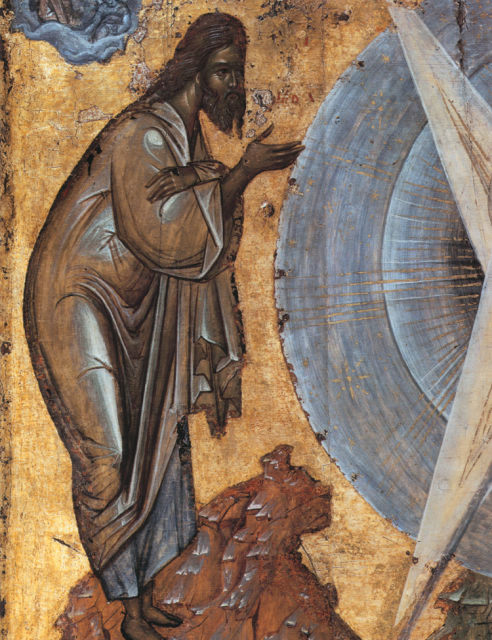
MASTER OF THE CIRCLE OF THEOPHAN THE GREEK. Transformation.Fragment
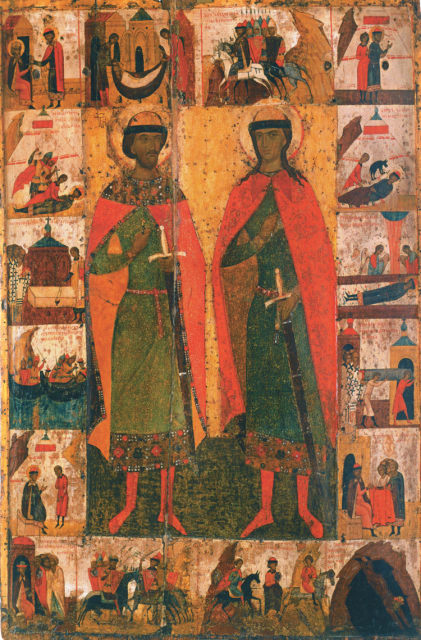
Boris and Gleb with life.Second half of the 14th century Moscow. State Tretyakov Gallery, Moscow
Boris and Gleb, the younger sons of Prince Vladimir of Kyiv, were treacherously murdered shortly after their father's death on the orders of their older half-brother Svyatopolk, who wanted to conquer the throne of Kyiv. They became the first Russian saints to be canonized by the Russian Orthodox Church in 1071. The images of the brothers in the middle of the icon are bright and clear, their faces are filled with “perfect” love, which “casts out fear”. The stamps represent scenes from the life of Boris and Gleb, where, based on several chronicles and literary sources, they tell about their “death” and the inglorious death of the insidious Svyatopolk, who was defeated by Yaroslav the Wise and fell into the open ground “between the Czechs and the Poles”.
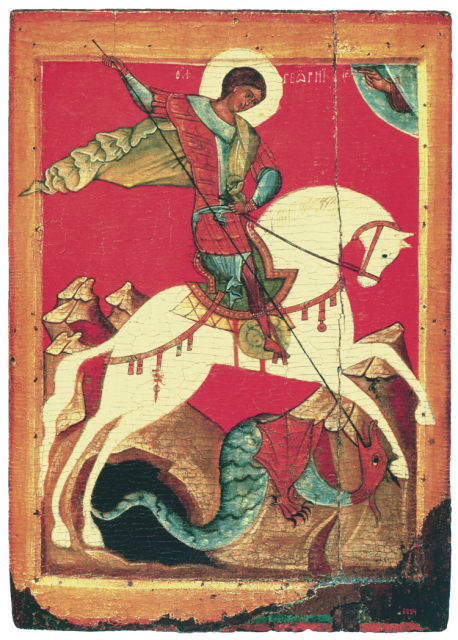
George's miracle about the snake.Early 15th century Novgorod. State Russian Museum, St. Petersburg
According to the Byzantine version of the legend, St. George, heading to Cappadocia, saw the crying princess. She told him that a terrible snake appeared near her hometown, which demands the children of the townspeople as a sacrifice. And now the turn has come to her - the king's daughter. St. George, having overshadowed himself with the sign of the cross and calling on the Lord, rushed at the serpent, and “hitting the serpent with force in the larynx, struck him down and pressed him to the ground; the horse of the saint trampled the serpent underfoot.” After that, George ordered the princess to tie the snake with a belt and lead it to the city. The inhabitants of the city, amazed by the miracle that had happened, adopted the Christian faith. On the remarkable icon of the Novgorod school of St. George appears in all the "heavenly" splendor: his cloak flutters spectacularly behind his back, the white horse rears up and tramples the snake, the spear cuts the air like lightning, piercing the monster's mouth. At the top right, in the blue segment, the Lord blesses the saint for battle. The impression of the bright triumph of good over evil is completed by the bright red background of the icon.

Elijah the prophet.Middle XV. Novgorod. State Tretyakov Gallery, Moscow
Novgorodians revered the Old Testament prophet Elijah as a mighty thunderer, endowed with supernatural abilities to command the forces of nature, and as an ascetic, a devout servant of the will of God and a God-seer.
Prophet Elijah on the famous red-figure Novgorod icon gives the impression of a man endowed with superhuman energy. The bony, strict, radiant face of a gray-haired old man, sloping shoulders, an elongated, “flaming” silhouette emphasize the incorporeality of the figure, its aspiration upwards.

Miracle about Flora and Lavra.End of the 15th century Novgorod. State Tretyakov Gallery, Moscow
Saints Flor and Laurus were revered as gracious intercessors for the needs of the peasant and patrons of his main wealth - horses. Against a sparkling golden background of a colorful, as if “fairy-tale” icon, Flor and Laurus are depicted in the upper field, to whom Archangel Michael hands over the reins of two horses under elegant saddles. Below the horse breeders - the holy martyrs Speusippus, Eleusippus and Melevsipp - are driving a herd of horses to a watering hole. The horses on the icon appear as a symbol of day and night, the endless running of time. Their outlines resemble the silhouettes of the wide wings of an archangel - thereby emphasizing the unity of the world of the mountain (heavenly) and the valley (earthly).
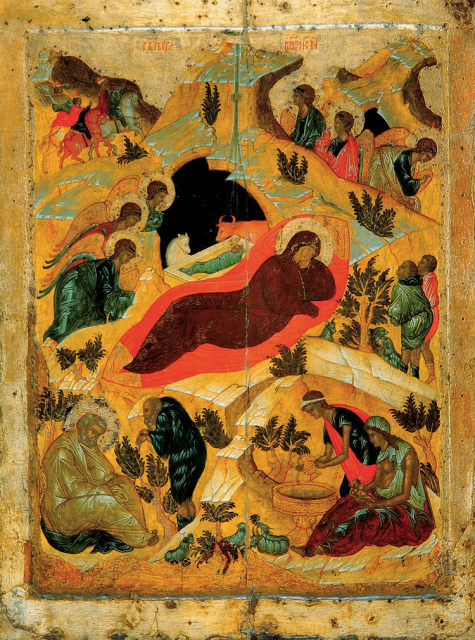
Nativity.1410–1430? Moscow. State Tretyakov Gallery, Moscow
The central place of the icon is occupied by the figure of the Mother of God on a scarlet couch. Near it, against the backdrop of a gloomy spot of the cave, is a manger with the Christ Child. Scenes leading up to and following Christmas unfold around them. In the upper left corner, seeing the guiding star of Bethlehem that appeared in the sky at the moment of the birth of the Savior, a group of Magi goes to bow to the Infant. On the right, angels are preaching to the shepherds about the coming of the Savior. In the lower part of the icon, Joseph is immersed in a heavy thought: he could not immediately believe in the birth of the Son of God. Next to him is the scene of the washing of the Infant as a sign of purification from anxieties and doubts.

Position in the coffin.Last quarter of the 15th century Kargopol. State Tretyakov Gallery, Moscow
According to the Gospel, the secret disciple of Christ, Joseph of Arimathea, a member of the Sanhedrin, who did not participate in the trial of Christ, begged the Roman governor, Pontius Pilate, to give him the body of Jesus for burial. The body removed from the cross was wrapped in clean linen soaked in incense and laid in a coffin carved into the rock. The Mother of God, John the Theologian and Joseph of Arimathea, full of sorrow, fell to the tomb with the body of Christ. One of the myrrh-bearing women (who brought myrrh - incense for the body of Christ) in despair raises her hands to heaven. This tragic gesture is repeated in the outlines of the rocky mountains, full of monumental grandeur, which, like streams of tears, fall down in steep ledges.
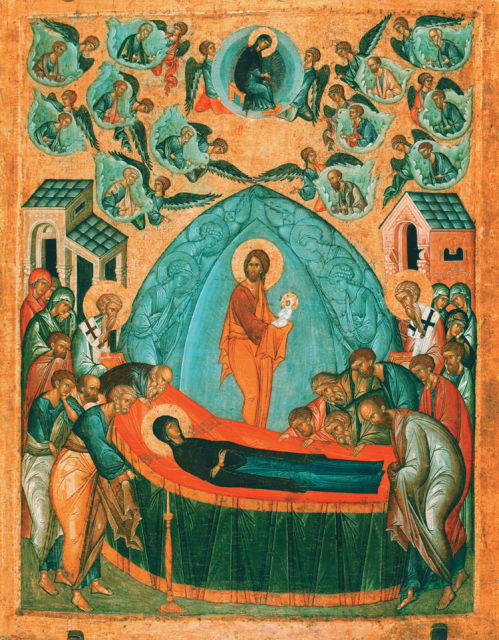
Assumption of the Mother of God.End of the 15th century Tver. State Tretyakov Gallery, Moscow
According to apocryphal texts, the Mother of God, having learned from the archangel Gabriel about her imminent death, offered up a prayer so that she could say goodbye to the apostles - the disciples of Christ. In the upper part of the icon, angels on exquisite, bird-like clouds carry the apostles, who had scattered all over the world by that time, to the bed of the Mother of God. Christ, around whom a cloud (mandorla) shines - a symbol of his Divine nature, accepts her sinless soul (symbolically depicted as a baby), and the Mother of God through him acquires the Kingdom of Heaven.
The bright, luminous blue color of the cloud is repeated in the clothes of the apostles, on the roofs of buildings and on the wings of angels. For this abundance of blue, rare in ancient Russian painting, the icon received the name "Blue Assumption".
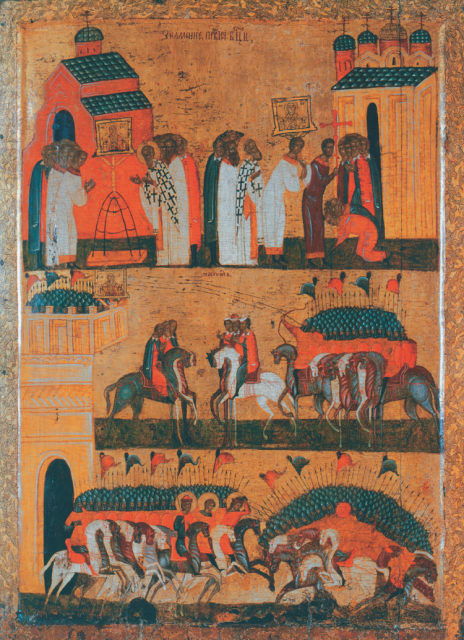
Second half of the 15th century Novgorod. State Tretyakov Gallery, Moscow
In this icon, Russian icon painting for the first time refers to the battle genre, which is not found in Byzantine painting. The plot is based on a real historical event - on February 25, 1170, independent Novgorodians defeated the Suzdal army led by Prince Mstislav Andreyevich, the son of Andrei Bogolyubsky. According to legend, the victory was won thanks to a miracle, which was revealed by the Novgorod icon "Our Lady of the Sign".
In the upper register of the icon, the shrine is solemnly transferred to the main temple of Novgorod - St. Sophia Cathedral. On average, ambassadors of the warring parties meet, and the battle immediately begins - arrows fly at the defenders of Novgorod, hitting the miraculous icon on the fortress wall. “Our Lady of the Sign” “turned away” from the Suzdal people, shed a tear, and darkness attacked the conquering army in broad daylight.
Below we see the result of the miracle shown by the Heavenly intercessor. From the gates of the Novgorod Kremlin leaves the army, led by the patron saints George, Boris and Gleb. Two troops clashed with spears, but on the right the cavalry of the defeated Suzdalians had already turned back and left the battlefield.
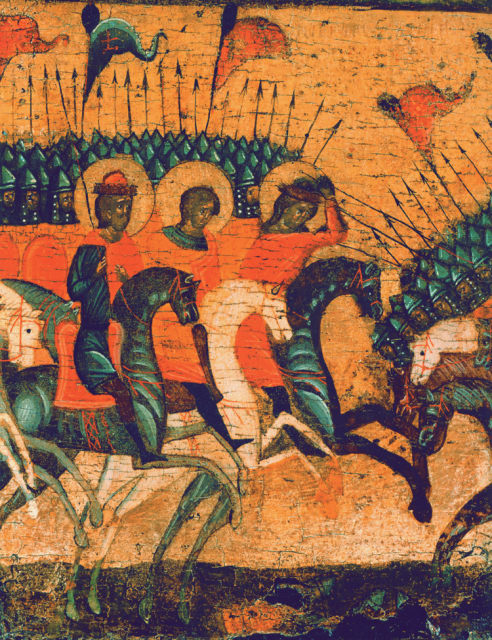
Miracle from the icon "Our Lady of the Sign" (Battle of Novgorodians with Suzdalians).Fragment
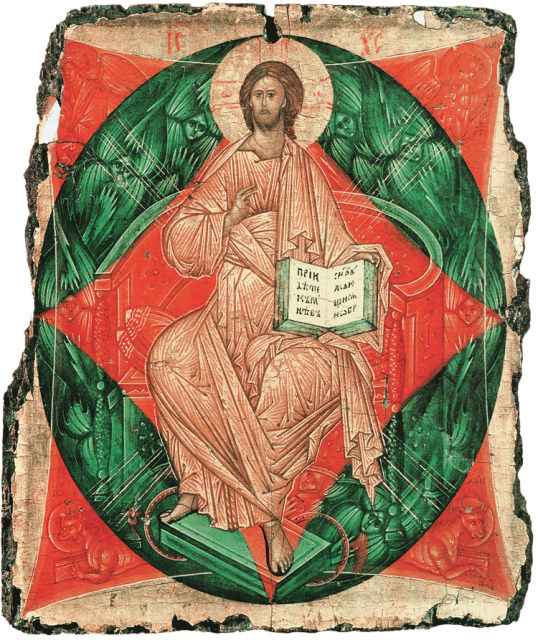
ANDREY RUBLEV, DANIEL CHERNY. Saved in the Force.1410s. Moscow. State Tretyakov Gallery, Moscow
"The Savior in Power" was the central part of the deesis tier of the large multi-tiered iconostasis of the Assumption Cathedral in Vladimir. Christ, as a formidable judge, sits on a throne - a symbol of the Universe and God's Glory. With his right hand he blesses, with his left he holds the Holy Scriptures. The red square symbolizes the earthly world, and the images of an angel, a lion, a calf and an eagle in its corners represent the four evangelists. The greenish oval is the spiritual world, in which the Heavenly Forces reside in the form of winged wheels. These are the so-called "thrones" - a kind of angelic ranks, which are always next to the throne of God. The red rhombus is a symbol of the invisible world. The majestic and solemn intonation of the composition of the icon is softened by the meek and soft face of the Savior - a fair judge, introducing a person into the realm of Goodness and Justice.

ANDREY RUBLEV, DANIL CHERNY AND WORKSHOP. Annunciation.1408. Moscow. State Tretyakov Gallery, Moscow
The Annunciation icon was part of the festive tier of the iconostasis of the Assumption Cathedral in Vladimir. Most researchers attribute it to the possible creations of Andrei Rublev or Daniil Cherny. The composition and drawing of the icon are distinguished by classical perfection and that unique spiritual fullness that is characteristic of outstanding works of icon painting. The archangel descended from heaven proclaims the good news to the Virgin Mary, who reverently bows her head as a sign of acceptance of the Divine will. The intricately flowing folds of the greenish tunic of the angel, sparkling with luminous gaps, make us recall the best examples of ancient monuments. The ray of the Holy Spirit comes from heaven and penetrates through the scarlet veil of the Jerusalem temple into the bosom of the Mother of God.
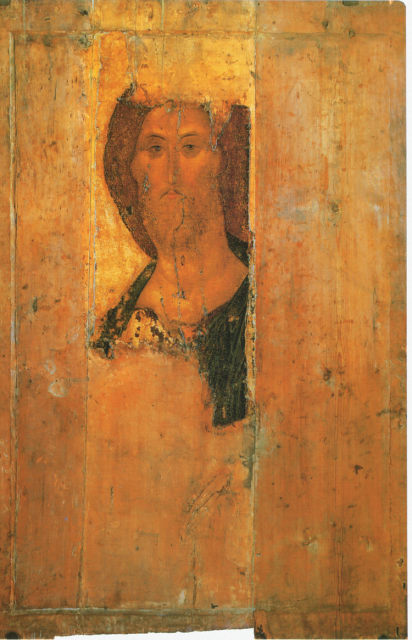
ANDREY RUBLEV. Saved.From the Zvenigorod rank. Beginning of the 15th century. Moscow. State Tretyakov Gallery, Moscow
Three darkened, dilapidated icons were found in 1918 by an expedition of restorers in a woodshed not far from the Assumption Cathedral on Gorodok in Zvenigorod. After clearing and restoration, it was found that the "Zvenigorod rank" is, perhaps, part of the iconostasis of this cathedral and the earliest of Andrei Rublev's works that have come down to us. Compared to the Byzantine prototypes, Rublev’s image of Christ is devoid of harshness and cold detachment, he appears as the embodiment of softness and sincerity, as the concentration of the Divine light of the mountain world, as the most perfect example of eternal harmony and love. His philosophically focused and at the same time meek face seems to be directed into the soul of the one who prays - upon contact with him, the radiance of Divine glory becomes obvious, directly penetrating into us.
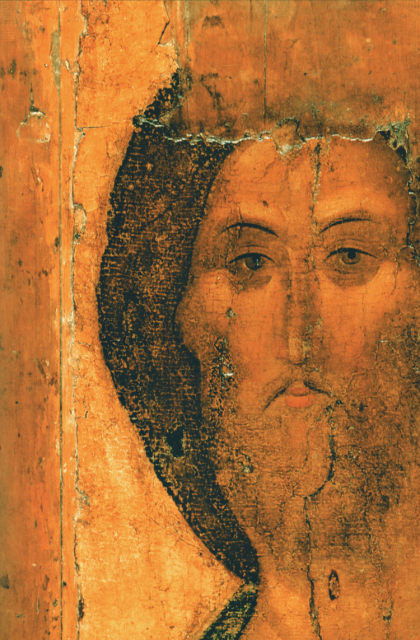
ANDREY RUBLEV. Saved.Fragment
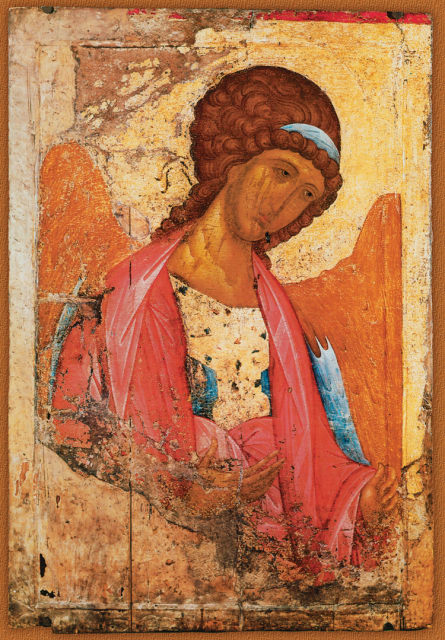
ANDREY RUBLEV. Archangel Michael.
Archangel Michael is part of the heavenly forces standing before Christ, praying at the time of the Last Judgment for the human race. The face of the archangel - sincere and thoughtfully contemplative - bears the imprint of a beautiful and perfect mountain world. In this image, the Hellenic fundamental principle of Rublev's creativity is especially noticeable: harmonic clarity and harmony, contemplative peace and sublime beauty.

ANDREY RUBLEV. Apostle Paul.From the Zvenigorod rank. Early 15th century State Tretyakov Gallery, Moscow
This icon also softens the features of Byzantine severity, common to all previous iconography of the Apostle Paul. The saint appears as a wise philosopher, immersed in thoughtful contemplation. Restrained coloring is built on a harmonious combination of greenish-ocher and blue tones with gaps. The golden background and nimbus emphasize the stay of the apostle in the eternal radiance of the mountain world.

ANDREY RUBLEV. Trinity.OK. 1425–1427 State Tretyakov Gallery, Moscow
Trinity is the only indisputable work of Rublev. AT Old Testament tells how God appeared to the elder Abraham and his wife Sarah in the form of three husbands-angels. Abraham and Sarah prepared a meal for them, then one of the angels predicted to the elderly spouses the birth of the long-awaited heir, the son of Isaac, who would become the founder of the “great and strong” people.
According to Christian doctrine, God appears to man in three different hypostases. The left angel on the icon is God the Father. A house rises above it as a symbol of the creation of the world. The central angel is God the Son, that is, Christ, who will sacrifice himself for the sake of people and rise again; above it is a tree - a symbol of the resurrection and the cross. The right angel, the Holy Spirit, is the eternal Divine principle of the world; above it is a mountain, a symbol of spiritual ascent. The central place in the icon is occupied by a bowl on the table - a symbol of Christ's sacrifice.
The idea of unity is the essence of Rublev's "Trinity", it is expressed in the icon as the ideal of love and harmony that should reign in the world.
The icon was made for the Trinity Cathedral of the Trinity-Sergius Lavra, where there is a coffin with the relics of the founder of the monastery, St. Sergius of Radonezh. According to legend, the “Trinity” was created “in praise” of Sergius of Radonezh, who dreamed of “so that the hated strife of this world would be defeated by looking at the Holy Trinity.”
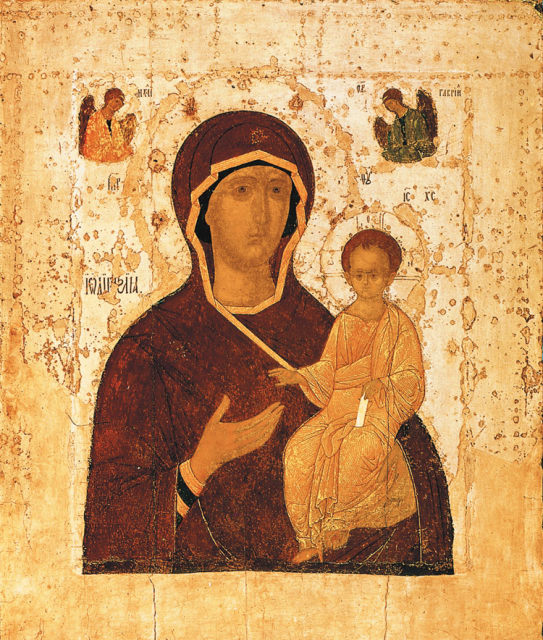
DIONYSIOUS. Mother of God Hodegetria.1482. State Tretyakov Gallery, Moscow
According to chronicles, in 1482, during a fire, the glorified miraculous icon of the Hodegetria Mother of God, brought from the Odigon Monastery in Constantinople, was burned, losing its paint layer. Dionysius on the same board made an exact copy (“in the same measure, in the same image”) of the affected icon.
Translated from the Greek "Hodegetria" - "Guide", that is, the one that accompanies and protects a person on the way to the Kingdom of Heaven. The Mother of God in this iconographic type is depicted frontally, with the Christ Child sitting on her left hand, her right hand raised to her chest in a prayerful gesture. In the upper corners of the icon are the bowed half-figures of the archangels Michael and Gabriel.

End of the 15th century State Tretyakov Gallery, Moscow
Metropolitan Alexy (1292/1298–1378) was the de facto ruler of Muscovite Russia during the early years of Grand Duke Dmitry Donskoy. With his spiritual authority, he contributed to the cessation of strife between the specific princes and the strengthening of the state, which ultimately led to victory at the Kulikovo field in 1380.
The hallmarks of the top row depict plots about the birth of Alexis, his apprenticeship, his tonsure as a monk, and his appointment as bishop of Vladimir. This is followed by stamps with the image of Alexy in the Golden Horde in front of the Tatar Khan - he "quenches the wrath of Khan Berdibek." The foundation of the Spaso-Andronikov Monastery is reminiscent of a stamp where Alexy asks Sergius of Radonezh to release the disciple Andronik to be abbess at the Spassky Monastery. The compositional perfection in the icon stands out for the plot where Alexy persuades Sergius of Radonezh to become his successor (Sergius, as you know, refused). The last row traditionally contains hallmarks associated with dormition, burial, and miracles that took place at the tomb of the saint. This hagiographic icon belongs to the best creations of Dionysius. Conciseness and compositional perfection, the flattening of ethereal, elongated figures, the sophistication of the color scheme create a feeling of wonderful visions of the mountain world, the coming Kingdom of God.

DIONYSIOUS AND WORKSHOP. Metropolitan Alexy with his life.Fragment

DIONYSIOUS. crucifixion.1500. State Tretyakov Gallery, Moscow
The icon was part of the festive tier of the iconostasis of the Trinity Cathedral of the Pavlovo-Obnorsky Monastery near Vologda. For the first time on the icon "Crucifixion" there is an image of the Synagogue flying away from the cross and the New Testament Church flying up. According to Christian doctrine, the establishment of the New Testament Church is directly connected with the sacrifice on the cross. In the elegant, ornate icon of Dionysius, the theme of sacrifice on the cross and suffering is muted. A bright, joyful expectation of the coming Resurrection and eternal life prevails here.
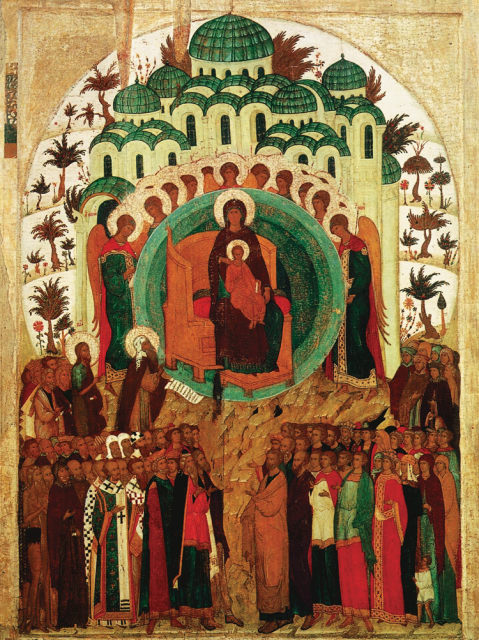
DIONYSIOUS AND WORKSHOP. "He rejoices in you."Early 16th century State Tretyakov Gallery, Moscow
The icon is based on the text of the Mother of God prayer “Rejoices in You…”.
Icons and frescoes illustrating liturgical chants have been common in Byzantium and the Balkans since the 14th century. In Russia, such images became especially popular at the turn of the 15th - 16th centuries. The main elements of the composition correspond to the verses of the chant. The image of the Mother of God on the throne is surrounded by an "angelic cathedral". The “human race”, aspiring to the Mother of God, is represented by the cathedral of all saints, headed by John the Baptist. The composition is crowned with the image of a temple-paradise. The icon conveys the feeling of a single liturgical action that binds all its participants. The vital meaning of this icon is that “the world is not chaos.<…>There is a mother’s loving heart, which must gather the universe around itself” (E. Trubetskoy).

OK. 1502–1503 State Russian Museum, St. Petersburg
The plot of the icon is taken from the apocryphal Gospel of Nicodemus. Satan, having learned about the death of the Savior, ordered to lock the doors of hell, where all sinful souls have been languishing since the expulsion of Adam and Eve from paradise. At the hour of the Resurrection of Christ, the doors of hell collapsed. Having descended into hell, Christ ordered the angels to bind Satan, and he himself, having forgiven Adam and Eve, led them out of hell with other righteous people. On the icon, Christ is depicted in a sky-blue circle of Glory, inside which are angels with white scrolls on which the names of virtues are written: mercy, repentance, peace, truth ... Christ gives hands to Adam and Eve, leaving the graves, other people look at the Savior with joyful hope. In the depths of the cave of hell, two angels capture Satan. In the upper part of the icon, three angels solemnly erect a cross - a symbol of the Resurrection.
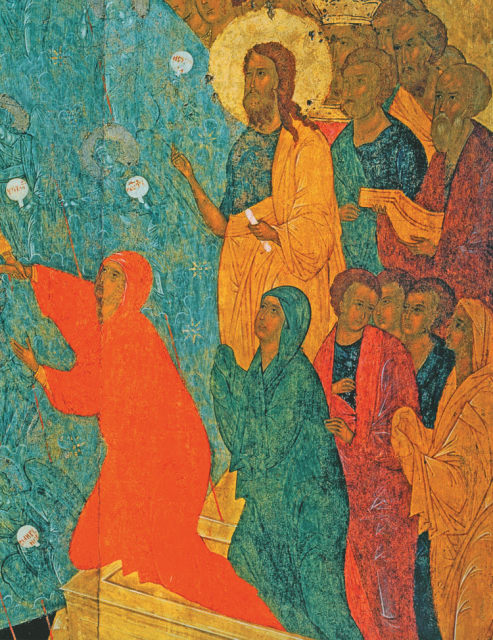
DIONYSIOUS AND WORKSHOP. Descent into hell.Fragment

1550s. Moscow. State Tretyakov Gallery, Moscow
Before us is a church-historical allegory glorifying the Orthodox kingdom in the traditional forms of icon painting. It was probably ordered by Ivan the Terrible after the capture of Kazan in August 1552.
In the upper right corner, in a semicircle, Kazan is depicted blazing in flames, which is presented in the form of an allegory - the lost Old Testament kingdom (or Sodom). On the left, we see the city of purity and truth crowned with a tent - Heavenly Jerusalem, which can be read as an image of Moscow, the capital city of the victorious Orthodox kingdom. At the top of the Heavenly City, the Mother of God sits with the Infant Christ, passing the martyr's crowns to the angels, who crown the soldiers with them. The name of the icon - "Blessed be the army of the heavenly king..." - is taken from the liturgical hymns dedicated to the martyrs who died for the faith. In the center of the icon in the form of a man in luxurious royal attire and with a cross in his hands, who rides a horse surrounded by retinue, some experts see Ivan the Terrible himself. Others believe that this is Prince Vladimir Monomakh or the Roman Emperor Constantine the Great.
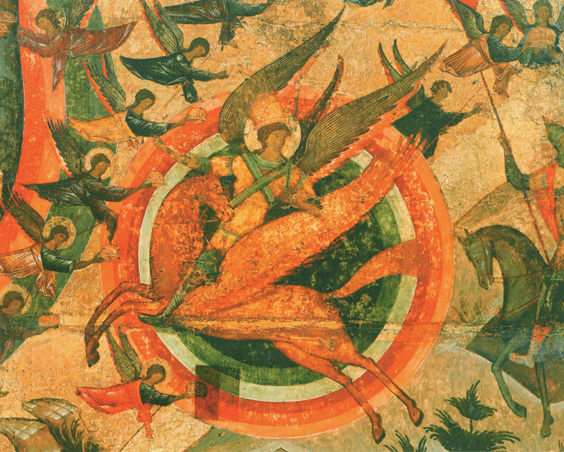

“Blessed be the host of the heavenly king…” (Church militant).Fragments
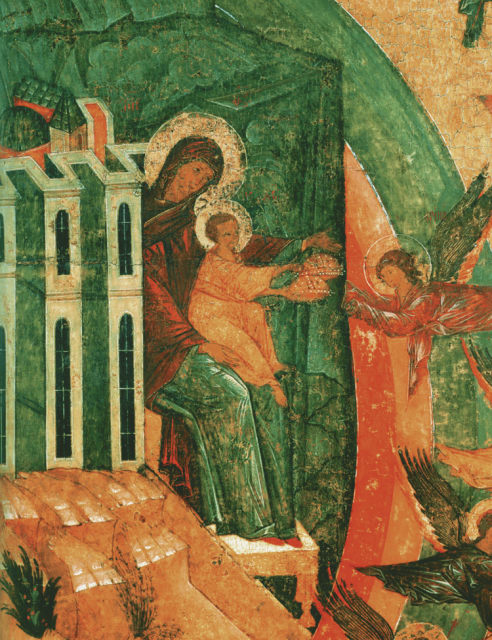
“Blessed be the host of the heavenly king…” (Church militant).Fragment
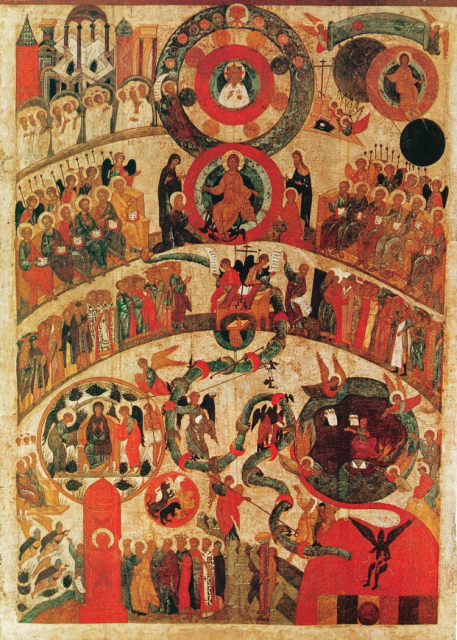
Terrible Judgment.Mid 15th century Novgorod. State Tretyakov Gallery, Moscow
The complex, multi-plot iconography of the icon is based on the texts of the Revelation of John the Theologian, gospel parables, hagiographic writings. In the central part, Christ the Judge in Glory is depicted, who is surrounded by the Mother of God, John the Baptist, Adam and Eve who fell to the throne, two groups of archangels and twelve apostles on the thrones. On both sides of the throne, the righteous and sinners await the Last Judgment. In the lower right part, angels push sinners into the fiery abyss. In the "fiery Gehenna" Satan himself with the soul of the traitor Judas in his arms. From the mouth of the fiery hell to the feet of Adam rises a road resembling a snake. On it are rings with figures of devils, symbolizing the ordeals of sinners. Below on the left is the general resurrection of the dead, the Mother of God on the throne, the joy of the righteous in paradise. The composition is crowned by God the Father in the midst of the Kingdom of Heaven.
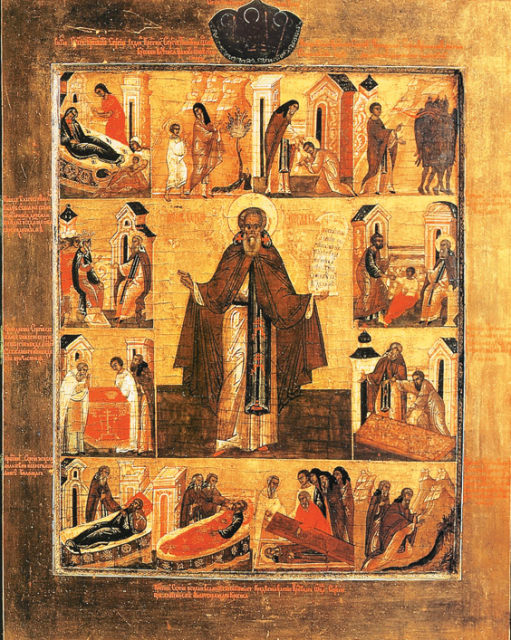
Rev. Sergius of Radonezh. In 12 hallmarks of life.Mid 16th century State Russian Museum, St. Petersburg
Sergius of Radonezh (1314-1392) - the founder of the Trinity-Sergius Lavra, the great Russian saint, "abbot" (i.e., rector) of the Russian land. With his spiritual authority, he prevented strife, contributed to the strengthening of a single state, liberation from the Mongol-Tatar yoke. The image of Sergius in the middle of the icon has a portrait character: a characteristic high-cheeked face, slightly slanting eyes, light thick hair ... In the face of the saint - all the depth and strength of sorrow for the whole Russian land. The hallmarks are based on the life of Sergius, written in the 15th century by his student Epiphanius the Wise.
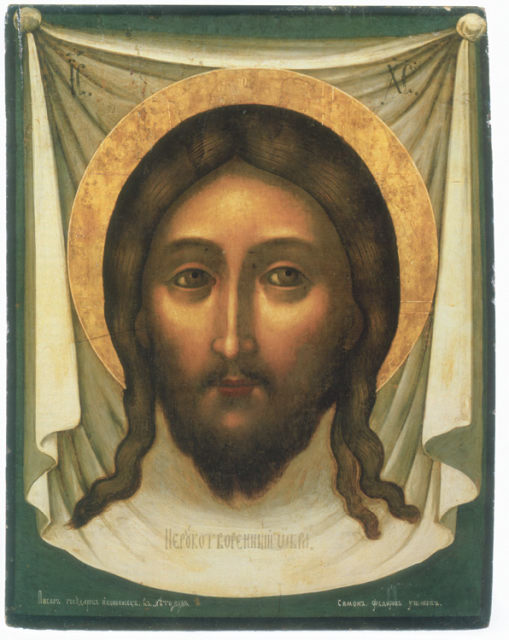
SIMON USHAKOV. Savior Not Made by Hands.1658. State Tretyakov Gallery, Moscow
The icon comes from the Moscow Trinity Church in Nikitniki. The royal painter Simon Ushakov applied here new pictorial techniques of icon painting: light and shade modeling of volume, accuracy in rendering details. The master, undoubtedly, used the aesthetic treatise of his friend and associate, the icon painter Joseph Vladimirov, according to which “the carnal appearance of Christ was bestowed by him, therefore, he had to be conveyed as accurately as possible - that is, “light and ruddy ... and more lifelike”. Otherwise, the divine testimony will be distorted. This new canon of the image of Christ is the basis for the image of the Savior Not Made by Hands Ushakov and later similar icons. At the same time, this image does not break with the traditional methods of icon painting: the lighting on the face is not motivated by a real light source, the arrangement of light patches is the same as on the icons since the 16th century.
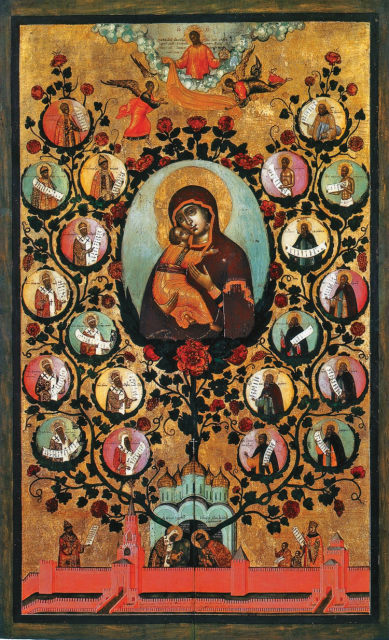
1668. Moscow. State Tretyakov Gallery, Moscow
For the first time in Russian art, this icon represents reflections on Russian history and on the greatest Russian shrine - Our Lady of Vladimir.
The Moscow State Tree is planted by the Moscow Prince Ivan Kalita and the first Moscow Metropolitan Peter, whose branches sprout through the Assumption Cathedral. The image of the Vladimir Mother of God - the main patroness and intercessor of the Russian state - overshadows and unites the whole tree. Lush pink-red flowers bloom on its branches, bunches of grapes hang down as a reminder of the Garden of Eden that awaits the righteous. Among these "paradise" are the fruits of the tree of the state of Moscow - medallions with the images of the rulers of the spiritual and secular, who, with their tireless labors and deeds, contributed to the growth and prosperity of this tree.
Tsar Alexei Mikhailovich with Tsarina Maria Ilyinichnaya Miloslavskaya and two sons are standing behind the Kremlin wall in front of the tree.
In the upper part of the icon, among the heavenly radiance, Christ holds the royal crown and robe for Alexei Mikhailovich as a sign that royal power is given from God.
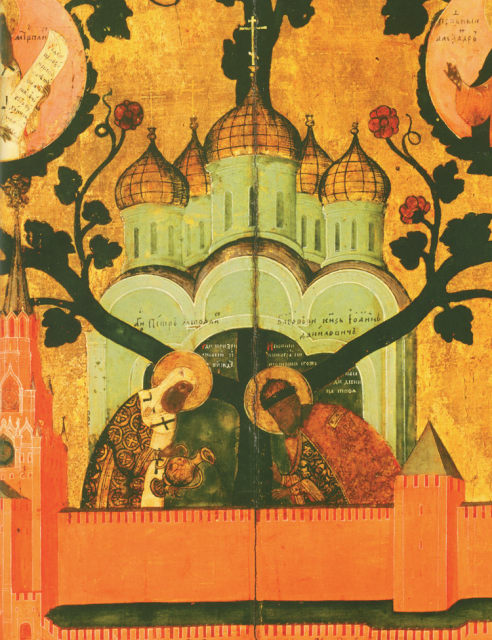
SIMON USHAKOV. Planting the tree of the state of Moscow.Fragment


SIMON USHAKOV. Planting the tree of the state of Moscow.Fragments
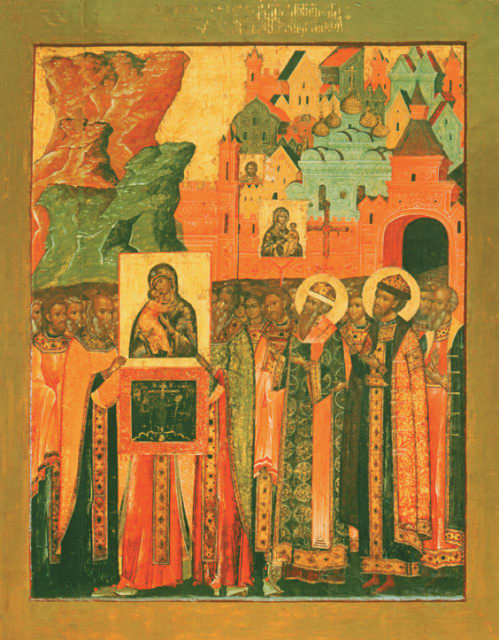
Meeting of the icon "Our Lady of Vladimir".Mid XVII. Moscow. State Tretyakov Gallery, Moscow
In 1395, Moscow was threatened by the invasion of a terrible enemy - Tamerlane (or Timur). The Grand Duke of Moscow Vasily Dmitrievich sent to Vladimir for the miraculous icon of the Mother of God so that she would save the city, and on August 26 it was brought to Moscow. On the same day, Tamerlane withdrew his troops. Upon returning to Moscow, the prince prostrated himself before the miraculous icon and, in memory of the meeting (meeting) of Our Lady of Vladimir, founded the Sretensky Monastery.
In this icon, the solemn meeting of the shrine is conveyed with detailed historical details. A crowded procession with an altar cross and miraculous icons comes out of the Spassky Gates of the Moscow Kremlin. The clergy solemnly carry the "Our Lady of Vladimir" towards the procession. The icon is met by Metropolitan Cyprian and Grand Duke Vasily Dmitrievich in luxurious ceremonial vestments.
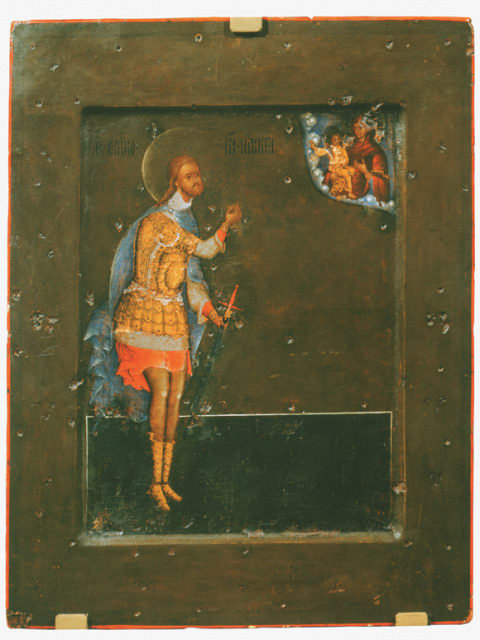
PROKOPIY CHIRIN.
Nikita the warrior.
1593. Moscow. State Tretyakov Gallery, Moscow
Prokopy Chirin is one of the most famous "sovereign masters" of the "Stroganov school". This icon was created by order of Nikita Grigoryevich Stroganov and was in the Annunciation Cathedral of Solvychegodsk. Patron of the customer, St. Nikita, lived in the 4th century; for professing Christianity, he was thrown into the fire by enemies, but remained unharmed. The characteristic "pettiness" of writing, the sophistication of drawing and color, the abundance of ornamentation turn the icon into a masterfully executed, precious sacred relic. The saint’s armor is striking in its beauty: a blue cloak with picturesque folds, gold chain mail painted with a delicate pattern, a bright red hem of the lower shirt, a sword hilt decorated with precious stones ... The fragile, ethereal, elongated figure of the saint resembles a flaming candle - he is all directed towards the Mother of God, who blesses it in the top segment of the icon.

SEMEN SPIRIDONOV.
Elijah the prophet. In 26 hallmarks of life.
1678. Art Museum, Yaroslavl
In the icon of the royal iconographer Semyon Spiridonov Kholmogorets (the artist was originally from Kholmogory), the virtuosity of the “petty” painting technique continues the traditions of the “Stroganov school”. The prophet standing before God-Sabaoth with a scroll in his hand is given in a three-quarter turn; The centerpiece of the icon is framed by a golden patterned arch on thin curly columns - a favorite decorative technique of the master. Typical Russian features are discerned in the hilly landscape.
![]()
Prince M. V. Skopin-Shuisky.
1630–1640s. Parsuna. State Tretyakov Gallery, Moscow
In the terrible years of the Time of Troubles, a talented military leader, the nephew of Tsar Vasily Shuisky, Mikhail Vasilyevich Skopin-Shuisky (1586–1610) managed to gather a militia in the northern cities and defeat False Dmitry II. We can imagine the appearance of this commander from a parsun written by an unknown royal painter.
Painting In Germany, as in other countries, wall painting existed as long ago as church architecture. Therefore, here, too, wall painting in the Romanesque era could develop further on the basis of its past. This does not mean that she remained in the national
author Woerman Karl 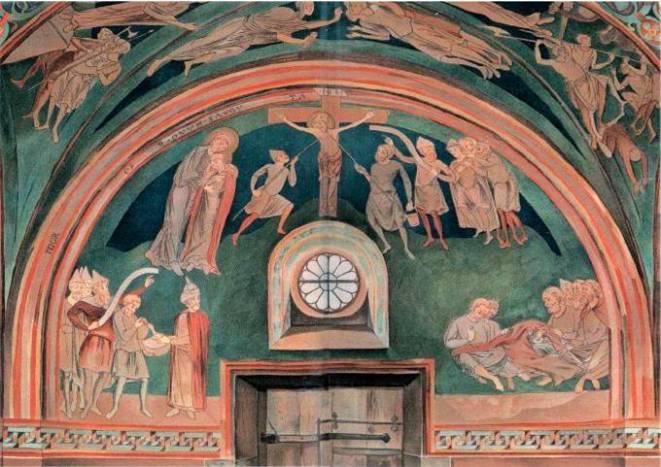
Painting The transition from Ottonian to Romanesque murals is particularly evident in those blessed High German lands where the snowy peaks of the Alps are still visible in the distance. First of all, the successes of the Reichenau school are curious (see Fig. 101). The step forward she took
From the book History of Art of All Times and Peoples. Volume 2 [European Art of the Middle Ages] author Woerman Karl 
Painting Fig. 227. Mother of God in glory. Part of the frescoes on the western empores of the cathedral in Gurk. According to Borrmann In the non-Rhine regions of southern Germany, wall paintings of the Romanesque era, which have historical and artistic significance, have been preserved almost exclusively in the Alpine countries. From
From the book History of Art of All Times and Peoples. Volume 2 [European Art of the Middle Ages] author Woerman Karl 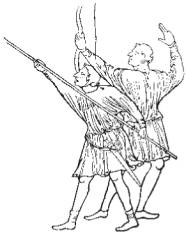
Painting while Gothic architecture and sculpture possessed a high technique, late medieval painting as a colorful planar image still lacked the knowledge of perspective and modeling with the help of chiaroscuro. Scientists have noted that "abbreviated
From the book History of Art of All Times and Peoples. Volume 2 [European Art of the Middle Ages] author Woerman KarlPainting Perhaps precisely because the main artistic movement of this era came from the north of France, traditional wall painting survived longer in the south than in the north. The frescoes in the apse of the church of Montmorillon (dep. Vienne), written around 1250, represent the style
From the book History of Art of All Times and Peoples. Volume 2 [European Art of the Middle Ages] author Woerman KarlPainting Gothic architectural style brought French forms to Spanish painting from the north; from the east, the great Tuscan school of painters of the fourteenth century brought her the style of Giotto. It is not our task to examine in detail the remains of Spanish wall painting,
From the book History of Art of All Times and Peoples. Volume 2 [European Art of the Middle Ages] author Woerman Karl 
Painting English churches and castles have always been decorated with frescoes. Unfortunately, executed between 1263 and 1277. master William Old Testament, allegorical and historical (the coronation of the king) frescoes in the room of Edward the Confessor in the Palace of Westminster and painted
From the book History of Art of All Times and Peoples. Volume 2 [European Art of the Middle Ages] author Woerman KarlPainting During the first fifty years, painting gradually freed itself from the restless angular contour style into which it had degenerated towards the end of the Romanesque era, in order to move towards a more lively and at the same time more calm, although still symbolically stylish.
From the book History of Art of All Times and Peoples. Volume 2 [European Art of the Middle Ages] author Woerman Karl ![]()
Painting The direction in which painting develops (1250-1400) is the same everywhere; however, in different countries these parallel paths of development often open up different horizons for us. In the area covering Württemberg, Bavaria and Austria, painting, although not developed
From the book History of Art of All Times and Peoples. Volume 2 [European Art of the Middle Ages] author Woerman Karl 
Painting Upper and Lower Saxon painting 1250–1400, period high gothic, no longer has the artistic and historical significance that it had in the previous era. True, church and secular wall painting everywhere found wide application, but
From the book History of Art of All Times and Peoples. Volume 2 [European Art of the Middle Ages] author Woerman Karl 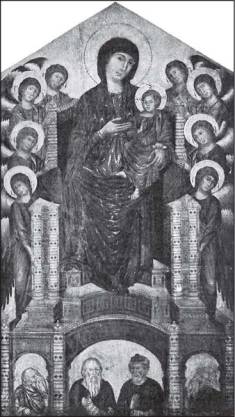
Painting Italian painting 1250–1400 allows us to better understand the spirit of that time than sculpture. The sculptural works of the north do not lag behind in their successes from the works of the artists of the south; in monumental painting after the middle of the 13th century, the predominant importance
From the book History of Art of All Times and Peoples. Volume 2 [European Art of the Middle Ages] author Woerman Karl 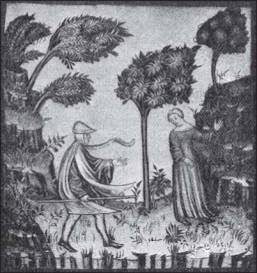
Painting The influence of Tuscan painting is felt in northern Italy. True, the figures of heroes painted by Giotto in the hall for festivities of the Palazzo Azzo Visconti in Milan have not been preserved, but his stay in Ravenna left traces visible to this day, and the Padua church
From the book History of Art of All Times and Peoples. Volume 2 [European Art of the Middle Ages] author Woerman Karl 
Painting Italy at this time is famous for its extensive wall painting. For the first time, large altarpieces painted on wood and altar boards with only one painting are joined in moderation by small portable individual paintings. More than
From the book History of Art of All Times and Peoples. Volume 2 [European Art of the Middle Ages] author Woerman Karl 
Painting The painting of northern Italy in the 15th century, like sculpture, was not free from Tuscan influences. As we have already seen, Masolino worked in Castiglione d'Olona, Gentile da Fabriano in Venice and Brescia, Uccello and Fra Filippo created known to us, unfortunately, only
From the book History of Art of All Times and Peoples. Volume 2 [European Art of the Middle Ages] author Woerman Karl 
Painting In the field of miniature, which was especially loved by both the popes and the kings of Aragon, the Eternal City can boast that it appeared the first Italian book with woodcuts - "Meditationes" by Cardinal Torquemada (1467), but by the engraving cutter and
From the book Lexicon of Nonclassics. Artistic and aesthetic culture of the XX century. author Team of authorsChristianity was adopted from Byzantium, and new types of art come from there: monumental (that which cannot be carried: fresco, mosaic), easel (icons, painting, sewing with a needle, book miniatures).
Iconographic canon also came from Byzantium. With the canon, we adopted strict laws that this canon cannot be violated.
The traditional material for creating mosaics was smalt. (Before that, stones + water were used). Smalt- pieces of glass welded with metals, which (metals) give special colors when heated, but this is quite expensive, in connection with this they were only mainly in Kyiv ( Kievan Rus). Smalt- colored artificial glass, made by special smelting technologies with the addition of metal oxides. The mosaic technique is inferior to the fresco technique.
fresco technique(egg paints) - minerals are rubbed, diluted with egg yolk, applied to wet plaster.
Fresco technique: A layer of plaster is applied to the wall, consisting of a mixture of river sand and crushed limestone. This composition is distinguished by a rather long drying period, during which chemical reactions giving it exceptional strength. Next, mineral paints are applied to the still wet surface. A prerequisite is the natural drying of the completed frescoes under the rays of the sun (the use of artificial heat treatment or chemicals is excluded). Thanks to this technique, the finished frescoes are not affected by any natural phenomena, no time.
Must see in the Temple from the left corner. The painting program is always created in advance. How to paint a temple - again the canons. Wall Paintings - Bible for the Illiterate.
Long before the baptism of Russia, in Byzantium, the canon:
Who is written
What is the turn of the body
Clothing color
Background color, eye
Icon - a visible symbol of the invisible world. According to legend, the most ancient icons are those that were not made by hands (the Savior Not Made by Hands) + what was written by the evangelists (those who knew both Christ and the Mother of God). Over the centuries, a whole system of narrative norms, special symbolism:
Main characters depicted in front or in 3/4
Secondary characters are smaller, more important and are depicted in profile.
Smooth divine light
Four seasons, one of the evangelists (there are 4 of them), one of the apostles is written for months (12)
- gold: divine radiance
- purple or scarlet: regal, Christ always has a purple tunic ͵ in the attire of the Virgin Mary (she gave birth to the king of kings)
- red: blood, love, sacrifice(The Annunciation is a red thread, a connection with the future sacrifice of Christ)
White: - divine light (Divine light differs from divine radiance (golden) in that white was depicted around saints, not necessarily deities), purity (Saints in white robes are depicted). Baby in a white veil - the purity of the soul and thoughts of the Virgin
- blue, cyan- sky
- green- youth, hope, nature, update
- brown- Earth, dust
- black- evil, death, hell, monks
Golden Threads: Assist(lat. assist- present) - in icon painting strokes of gold or silver leaf on the folds of clothes, feathers, wings of angels, on benches, tables, thrones, domes, - symbolizes the presence of Divine light, replacing spaces
Holy images:
Motionless, incorporeal, bodies are guessed by the folds of clothing. Assist - golden threads (thin brush), in the strands of Christ, for example, or the pattern on the Chiton of the Mother of God is such a divine radiance.
Landscape:
Often present in the icon, a kind of landscape. Often these are mountains, or simple trees (not an apple tree), cities that are depicted as solid fantastic buildings.
(Hill, Oak, Building - Trinity Rublev)
Symbols:
Circle - eternity, radiance of holiness
Around the head - a halo - from Latin - a cloud, ĸᴏᴛᴏᴩᴏᴇ means its holiness.
Past and future on the icon: early on the left, late on the right.
Reverse perspective- large at the back, because the one who is on the other side of the icon is important, the image should be closer to him, he is the main viewer (until the 17th century, so, then direct perspective)
Images of the Savior How is Christ portrayed?
1. "Savior Not Made by Hands"
2. "Christ the Almighty" or "Pantocrator" - God the Father - is always in the dome (in the St. Sophia Cathedral in Kiev - the arbiter of fate, described to the waist, looks at us all the time, a stern face - a judge, an image came from Byzantium, but the Russians then painted softer)
3. "The Savior on the throne" (the throne is a symbol of the universe and royal power)
4. "The Savior is in strength" - in the form of a judge. In an egg symbol of rebirth- an oval in blue, a rhombus - red + 4 evangelists, but not them, but their symbols, those creatures that accompany them, the icon itself on a golden background.
5. "Savior Emmanuel" (Emmanuel - translation - God is with us - 12-year-old boy - the image is enclosed in a circle + a scroll + blesses believers)
6. "Saved good silence" - the image of Christ before coming to the people - in a white robe with prayer hands
7. "Saved the vigilant eye" - a rare image, lies with open eyes, does not forget for a minute that he will atone for the sacrifice of people (there are magicians around him, animals, saints of the given area)
Theophanes the Greek (frescoes) - also big eyes, pupils, sees everything.
Images of the Mother of God:
1. "Oranta" - praying, depicted alone, with prayerfully raised hands, often called the "Indestructible Wall" - protects the faithful, usually depicted in the conch of the apse.
2. "Hodegetria" - from Greek - a guidebook, the image of the Mother of God with the baby on her left hand, in a frontal pose, on the left hand Christ, the right hand to the baby is raised with a pleading gesture, the baby holds a scroll in his left hand, with his right hand - blessing the faithful, a scroll - the text of the future Bible.
3. "Eleusa" or "Tenderness" - the Mother of God and the Child sit cheek to cheek
4. "Panagia" - from Greek - all-merciful, all-holy, full-length image with raised hands in prayer, differs from the oranta in that Christ is depicted in the bosom. Bosom - a circle on the chest of the Virgin.
5. "Sign" - rarely seen - half-length image of Panagia
6. "Agnosfitissa" ʼʼAgiosoritisʼʼ (I think that Korotkova made a mistake in the name) - from Greek - intercessor, full-length, facing right without a baby, sometimes with a scroll in her hand
Angels- seven orders of angels
Angel Attributes: cross and sword, because it symbols of spiritual struggle, sometimes angels hold the hand of a baby - an image of human souls.
Archangels- 7, Michael and Gabriel, Raphael, etc.
seraphim(from Greek) - fiery - this is the highest angelic rank - six wings- a symbol of higher spiritual abilities, usually on icons cover their faces(even they are not worthy to see God - I cover them with wings) Vasnetsov depicted faces, but this was, as it were, criticized
Cherubim(from Hebrew) - wisdom- write in the form of open human faces
Among the museum collections of Russian icon painting, the collection of icons of the State Russian Museum, along with the Tretyakov Gallery and the Historical Museum in Moscow, belongs to one of the main places. Its collection includes more than 5 thousand icons of the 12th - early 20th centuries. The emergence of the collection dates back to the time of the founding of the Russian Museum - by 1898. The first icons came to the museum from the Academy of Arts in St. Petersburg, in which from the middle of the 19th century. There was a Museum of Christian Antiquities. Among them were icons from private collections of famous collectors of antiquities - M.P. Pogodin and P.I. Sevastyanov.
Subsequently, the collection of the museum was quickly replenished by receipts from monasteries and private collections. Of particular importance was the donation of 46 icons by the Intercession Monastery in the city of Suzdal, most of which were kept in the sacristy of the monastery and were contributions from nuns belonging to famous and noble families. big role in future fate The collection of the Russian Museum was played by the acquisition in 1913 of a huge collection of the famous historian and collector Academician N.P. Likhachev, numbering about 1500 icons.
The number and high artistic level of the monuments of ancient Russian art collected in the Russian Museum made it possible to create here a kind of museum in the museum - "Ancient storage of monuments of icon painting and church antiquity named after Emperor Nicholas II", which was solemnly opened in 1914. The assignment of the ancient storage named after Nicholas II was not a simple expression of respect for the emperor. Nicholas II was directly involved in the creation of the Ancient Storage, donating large sums of money for the acquisition of works or bringing them as a gift, often as a "person who wished to remain anonymous." The ancient storage became the largest state collection of ancient Russian art in Russia.
After the revolution, which undermined the foundations of the country's spiritual culture, museums turned out to be almost the only reliable repository of monuments of church art. Thanks to the enthusiasm and efforts of museum staff, the funds of the Russian Museum began to concentrate works from many destroyed or closed churches and monasteries. Among them were icons from the largest monastery in the Russian North: founded in the 14th century. - Kirillo-Belozersky, as well as Alexander-Svirsky, Solovetsky, and other monasteries.
After the Great Patriotic War the collection continued to grow intensively, mainly due to expeditions to collect monuments of ancient Russian art. The museum organized such expeditions annually, and sometimes several times a year. The heyday of expeditionary activity falls on the 1960s. During these years, hundreds of icons of the XIV-XIX centuries were brought to the museum. Today, thanks to the efforts of several generations of museum staff, a collection of great historical and cultural value has been formed.
The main part of the collection consists of Russian icons originating from the major artistic centers of Ancient Russia, such as Novgorod, Moscow, Pskov, Yaroslavl, Vologda, Tver, as well as works by provincial masters. The most ancient icon of the collection is the famous "Angel of Golden Hair", created at the turn of the 12th - 13th centuries. The masterpieces of the collection also include icons from the iconostasis of the Assumption Cathedral in the city of Vladimir, associated with the name of the largest icon painter of the late 14th - first quarter of the 15th century. Andrei Rublev, a group of icons from the Cathedral of the Nativity of the Theotokos of the Ferapontov Monastery, on which the wonderful master Dionysius and his students worked in 1502. Of great interest are the works of the masters of the Stroganov school, the largest icon painter of the Armory of the XVII century. Simon Ushakov and others. Due to the large number and variety of monuments, the collection allows us to present with great completeness the path of development of Russian icon painting over almost seven centuries of its history.
In addition to icons by Russian masters, the museum houses a small collection of Byzantine and post-Byzantine paintings, as well as fragments of murals from ancient Russian churches, a unique collection of facsimile copies of frescoes, manuscripts and early printed books.






